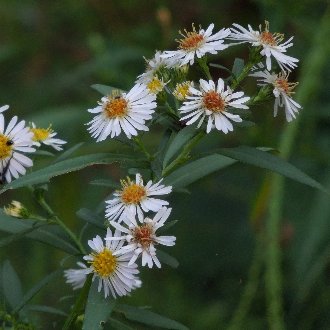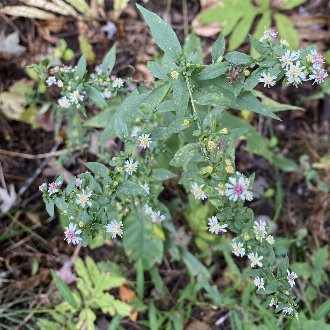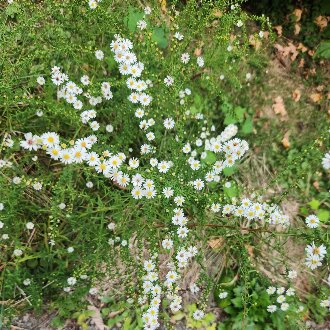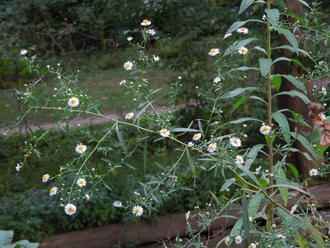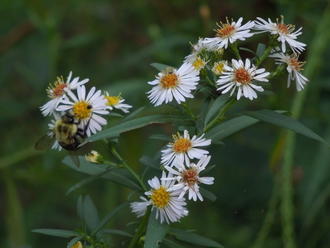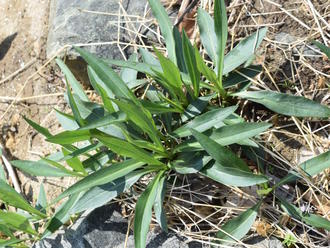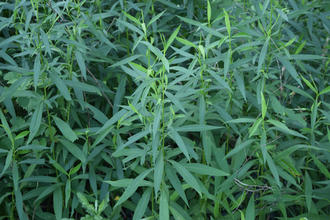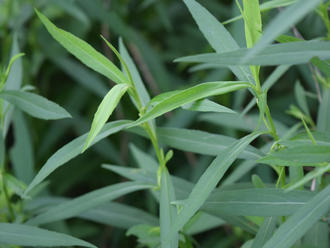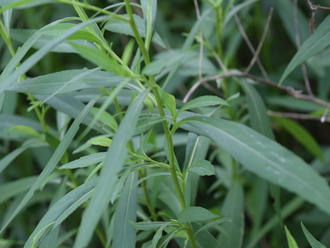White Panicled Aster (Symphyotrichum lanceolatum (Willd.) G.L. Nesom)
Also known as panicled aster, white panicle aster, lance-leaved aster; also classified as Aster lanceolatus Willd.
↑Summary
A thicket-forming perennial aster of moist, partly-sunny areas, native across North America.
↑Range - Expand
| Legend | Color |
| Native | |
| Native or Not Present |
This tentative map is based on our own research. It may have limited data on Canada and/or Mexico, and there is some subjectivity in our assignment of plants as introduced vs. expanded. Read more in this blog post.
Although this plant occurs somewhere in each of these regions, it may only occur in a small part of some or all of them.
↑Similar Plants
↑Habitat
Found in part sun and moist conditions, on poorly-drained sites that flood temporarily. This species is common in the northeast portion of its range, and found in a wider variety of habitats, but it becomes uncommon and more particular in the more arid western portions of it range as well as in the southern portions of its range.
Natural habitats include moist prairies, wet meadows, seeps, edges and openings in floodplain forests, swamps, margins of ponds, small lakes, rivers, streams, and marshes. Anthropogenic habitats include roadside ditches, areas where streams or drainage ditches flow through parks or suburban gardens, poorly-drained portions of vacant lots and waste ground, fencerows, pastures, and abandoned fields.
This species tolerates a wide range of soil types but requires ample moisture. It tolerates temporary flooding but needs soil that occasionally dries out. It can be found both in habitats with fast-moving and standing water. It ranges into full sun in the northern portions of its range.
↑Life Cycle
This species is a long-lived perennial that often forms large colonies through long underground rhizomes. It typically reproduces more vegetatively than by seed, but reproduction by seed is important for establishing on new sites.
Plants flower in fall, with a typical timing relative to other Symphyotrichum species. Seeds are wind-dispersed. Most seeds require cold dormancy and do not germinate until the spring of the following year, but some seeds can germinate immediately. Many seeds are not viable; the viable seeds tend to be the heavier ones. Germination is triggered more by temperature and moisture availability; light availability is less important for germination. We could not find information on whether or not this species forms a persistent seed bank. It is hard to study whether or not seed banking occurs because this species is so common and its seeds can travel far in the wind, so its establishment on a site following soil disturbance does not necessarily guarantee it was present in the seed bank. However, a number of other Symphyotrichum species are known to form a persistent seed bank so it is likely that this species also does.
Rhizomes mostly develop in the top 5cm of soil, with a few extending slightly lower; on established colonies, rhizome growth can be dense and become tangled. New stems tend to form at considerable distance from older stems, leading this plant to develop broad patches with each stem growing straight, rather than a clumping habit.
Established colonies can be long-lived, persisting for many years. We could not find information about its typical or maximum lifespan. Mortality is high for first-year plants, but plants that survive long enough to have a robust rhizome system usually live for a long time as they are able to move around to colonize suitable sites in changing conditions.
↑Faunal Associations
The foliage of this species is highly palatable to a wide variety of animals. Many mammals, including both wild ones and livestock, eat the foliage. White-tailed deer prefer this plant, and can eat plants to the ground. The foliage is also browsed by rabbits, horses, cattle, and sheep, and groundhogs eat various parts of the plant. Ruffed Grouse and Wild Turkeys eat both seeds and foliage. The seeds are eating by the American Tree Sparrow, white-footed mouse, and likely many other animals as well.
The flowers attract a wide variety of pollinators, including introduced honeybees (Apis sp.), bumblebees, and many other bees, numerous wasps, and also flies, butterflies, skippers, and beetles.
↑Uses
This plant is occasionally used as a gardening or landscaping plant; although it is easy to grow in gardens and has showy blossoms, it is often avoided because of its aggressive nature.
This plant makes a good cut flower, as its blooms tend to persist for a long time when a stem is placed in a vase of water, and it is also one of the showiest of the asters with white rays, and it tends to have and keep a neat, orderly appearance more than other asters.
It is used in riparian buffers and ecological restoration projects, as it competes favorably against invasive plants and its aggressive root system is good at holding soil. It often shows up on its own in suitable habitat, but it is also easy to transplant onto a site. Often the best way to utilize this plant is to learn to identify it and then avoid removing it when removing invasive plants, as some of it is likely to already be growing on suitable sites.
↑Links & External Resources
• Symphyotrichum lanceolatum (Panicled Aster) | Illinois Wildflowers (About This Site)
• Symphyotrichum lanceolatum (White Panicle Aster) | USDA PLANTS Database (About This Site)
• Symphyotrichum lanceolatum | Go Botany (About This Site)
• Panicled Aster | iNaturalist (About This Site)
• Symphyotrichum lanceolatum | Biota of North America Project (BONAP) (About This Site)
• Symphyotrichum lanceolatum | NatureServe Explorer (About This Site)
• Symphyotrichum lanceolatum | Flora of North America (About This Site)
• Symphyotrichum lanceolatum | Missouri Plants (About This Site)
• White Panicle Aster | Maryland Biodiversity Project (About This Site)
• White Panicle Aster (lanceolatum) | Maryland Biodiversity Project (About This Site)
• White Panicle Aster (latifolium) | Maryland Biodiversity Project (About This Site)
• Symphyotrichum lanceolatum (Willd.) G.L.Nesom | Plants of the World Online (POWO) (About This Site)
• Symphyotrichum lanceolatum (Panicled Aster) | Minnesota Wildflowers (About This Site)
• Symphyotrichum lanceolatum (Willd.) Nesom (Panicled Aster, Eastern Lined Aster) | Digital Atlas of the Virginia Flora (About This Site)



